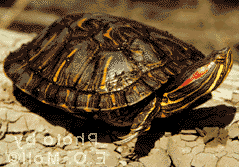
 |
|||||
|
|
 |
|
||||||
Caring for Your Turtle :: Turtles and TortoisesTurtles, numbering more than 245 species, inhabit areas ranging from the hottest deserts to the coldest oceans. As proper care requires close attention to natural history, your pet’s needs should be investigated carefully before you buy it.  Housing Housing
Although long associated with slow, deliberate movement, most turtles are extremely active and require spacious quarters. A 12-inch-long adult red-eared slider, for instance, needs at least a 55-gallon tank. Turtle enclosures must include a dry basking area and a sheltered “hideaway” such as a box, brush or leaf pile or - for burrowing turtles such as soft-shelled turtles - sand. Also provide a small area of water, which can be a bowl sunk into the tank. Most species of turtle require a substrate for dry areas of the tank. This is material you place on the bottom of the tank. If left to walk on a bare tank bottom, a turtle’s legs may grow splayed. The soft substrate may be leaves or pine chips or, for young terrestrial turtles, edible rabbit pellets that allow the young turtle’s feet to sink in for traction (they will also eat the pellets}. Desert species do best in dry sand or crushed oyster shell. The latter eliminates fungal growth. Aquatic turtles spend their time in a tank filled with water and so a bare tank bottom is fine. Think twice about using a gravel substrate at the bottom of the tank for appearance purposes. Gravel substrates are difficult to clean and the gravel may be swallowed. These species also require well-filtered, de-chlorinated water. De-chlorinating solutions can be purchased at most pet stores. For other turtles, be cautious about making the water area too deep or make certain to provide logs or rocks on which they can rest. Some turtles such as mud turtles are poor swimmers and young turtles will tire quickly. Many turtles can also be housed in outdoor enclosures if the temperatures are within their acceptable range. Box turtles, for instance, do well outdoors and will dig themselves a place to hibernate through the winter. Be sure that the enclosure provides areas of sun and shade, fresh water, and is protected from predators such as dogs, cats and raccoons. Light and Heat Seasonal temperatures and light cycles are vital to your turtle’s health. Wild-caught individuals of certain species, such as box turtles, will retain an internal clock and refuse to eat in winter even when kept warm. This can result in rapid loss of fat stores and can be dangerous. While the ambient temperature of your animal’s enclosure may be in the range of the 70s Fahrenheit, your pet will need access to a hot spot for basking. This can be provided by an incandescent lamp hung over the enclosure to create a basking area temperature of 85 to 100 degrees Fahrenheit, depending upon the species. At night, heat without light can be provided with a ceramic heater or heat pad, both available at pet stores. When lighting the tank, it’s imperative that you provide full spectrum light (UVA and UVB). This is required for the turtle to metabolize calcium and synthesize vitamin D3, both necessary for a turtle’s growth. Such lights, available at pet stores, should be positioned so that they illuminate the favored basking site, within 15 inches of your pet. Largely aquatic species, such as the musk turtle, seem not to require full spectrum light. Feeding The demands of shell growth necessitate a diet high in calcium and vitamin D3. Omnivorous species such as box turtles and sliders should be given whole fish, pre-killed pinky mice, snails, earthworms, insects and calcium-rich produce such as dandelion, blackberries, turnip greens and carrots. Spinach should not be given because it can lead to the formation of calcium oxalate stones. Forest tortoises such as the yellowfoot do well on mixed fruits and vegetables with a small amount of protein (1/8 of the diet) from earthworms or cat chow. Leopard tortoises and other desert dwellers are usually strict herbivores and require more dry material such as timothy hay and fewer fruits. An overabundance of protein in these species will cause shell deformities and early death. For all turtles, commercial turtle chows and trout chows generally provide good nutrition when supplemented with natural foods. How much to feed? A turtle’s stomach is about the size of its head so a meal should consist of an amount that will fill the animal’s stomach. Most turtles should be fed small meals daily, although adults can be offered a larger meal every 2 or 3 days. Food should be offered in bowls to prevent the turtle from ingesting the substrate. All foods should be coated with a vitamin and mineral supplement three times a week for juveniles, once a week for adults. Veterinary Care Before you purchase your animal, find a veterinarian who is experienced in caring for turtles. Arrange an appointment when you get your animal and have the vet do a fecal exam to check for salmonella. This disease is easily transmitted to humans, so pay attention to your own personal hygiene, washing your hands thoroughly after handling the turtle or anything it has come into contact with. Commonly encountered health problems include: Frank Indiviglio Related Articles: |
|||||||
| © 2006-2025 AnimalPets.org. Page generation 0.002 seconds. |